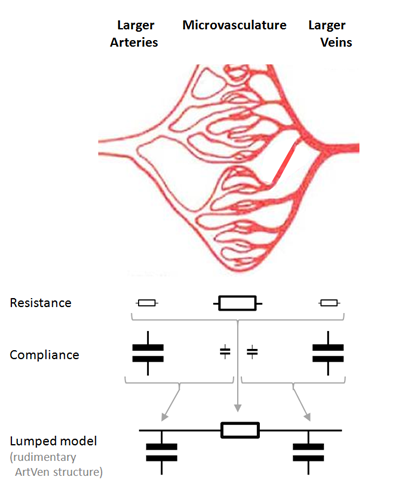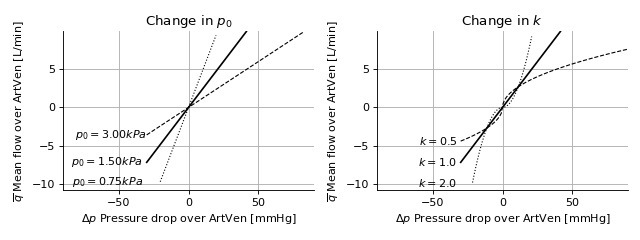ArtVen
Module summary
ArtVen connects two nodes with a passive, flow-dependent resistance.
Parameters
- k [-]: double
Exponent in pressure-flow relationship
- p0 [Pa]: double
Reference pressure at q=q0
- q0 [m 3/s]: double
Reference flow at p=p0
Signals
- q [m 3/s]: float
Flow over ArtVen
Physiological background
The blood circulation consists of a pump (the heart), conduits (larger blood vessels) and the microvascular beds of tissues and organs, that requires transport of nutrients to and waste products from them. The ArtVen module is designed to represent the hemodynamic load for a given vascular bed, either consisting of a confined section of tissue (e.g. skeletal muscle) or an organ (e.g. kidney or brain), or for an entire pulmonary or systemic vascular bed (spanning from valve to atrium). Such a given vascular bed is a branching network structure from the large feeding and draining vessels inwards (Fig. 6 ). Typically, blood enters via larger arteries, passes a microvascular part with the smallest vessels, and is drained by larger veins.

Fig. 9 Anatomical structure of a vascular bed and associated hemodynamic properties. The larger vessels at the arterial and venous sides contribute the most to the compliance of the bed, while the microvasculature contributes is the prime determinant of the relationship between flow through the bed and pressure difference across it. Because of these distributions the properties of a vascular bed can be represented by a lumped model.
Model Description
This module origins from the CircAdapt implementation as published by Walmsley et al.[1]. It is designed to simulate flow between two Tube0D objects. Thereby, this module simulates flow from the arteries to the veins through the microvascular system. This flow is given by Equation 1.
Numerical Implementation
In the CircAdapt Library, Equation 1 after the transmural pressures are calculated. Wave impedance is set to zero in this ArtVen module. To work together with PressureFlowControl, the proximal and distal flow are multiplied with \(f_{pfc}\) (see PressureFlowControl for more detail).
In the hemodynamic steady state, \(f_{pfc} = 1\) resulting in \(q = q_{prox} = -q_{dist}\).
The verification of this module can be found here
Sensitivity Analysis
Sensitivity of the ArtVen element is shown in artven_sensitivity.
(Source code, png, hires.png, pdf)

References
|
ArtVen connects two nodes with a passive, flow-dependent resistance. |